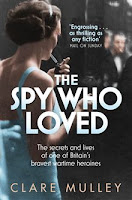Krystyna Sarbeck was born in Warsaw in 1908, the daughter of a Polish aristocrat and his Jewish wife. She had a privileged upbringing, but her aristocratic and Jewish heritage simultaneously positioned her as part of the elite and an outsider. It was a position she occupied her whole life, first in pre-Second World War Poland, then as a British agent in the Europe and the Middle East, and then in the post-war years before her untimely death in 1952, as Clare Mulley’s fascinating biography details.
Krystyna’s two great qualities were charisma and adventurous spirit, which were accompanied by a fierce independence and a subtle beauty. In her twenties she flitted between parties, skiing and horse-riding, marrying a businessman but separating shortly after. Moving in high society, she then met and married a rich diplomat. At the start of the war they were driving across South Africa, but on hearing that Poland had been invaded they immediately travelled to Britain. Within a few weeks Krystyna had used her charisma to secure a position in British intelligence.
With her husband posted to Paris, now named Christine Glanville, she moved to Budapest where she started to gather intelligence and aid escapees from Poland, later crossing the mountains into Poland, travelling round the country and establishing contact with resistance groups. Along with her lover, Andrzej Kowerski, she helped exfiltrate thousands of Polish servicemen, escaping arrest a number of times, and send on important information about German plans to invade Russia.
In May 1941, Christine and Andrezj drove from Budapest to Cairo via Istanbul. There she languished for a couple of years, undertaking training, attending parties, taking a string of well connected lovers, and demanding to see action. After a brief stint in Syria, she was eventually dropped into southern France prior to the Allied invasion. There she helped run a large resistance network, undertook a number of dangerous missions, and single-handed rescued three SOE agents from a prison three hours before their execution through guile and bluff.
As Mulley details, Christine Glanville was the first British female agent to serve in the field, was the longest serving female agent of the war, and she won the George Medal, OBE, Croix de Guerre and a host of medals. However, after the war she was quickly cut lose by the British, initially refused British citizenship and drifted rather aimlessly, unable to settle or find suitable work, despite having a network of highly influential friends. She took up a job as a steward on a cruise liner where she met a new lover who became obsessed with their relationship. When she ended the affair he fatally stabbed her in a hotel lobby.
Mulley does a generally excellent job at placing a coherent narrative on Christine’s story. This is no easy task as Christine herself told countless different versions and her friends and lovers also sought to mask or police her story, especially after her death. Nevertheless, and perhaps fittingly, Christine remains somewhat of an enigma, in part because she was highly complex and chameleon-like. She thrived on adventure and danger and excelled at playing parts, using her charisma to manipulate situations. Yet she could be difficult and seemed to exasperate as many people as she charmed. Mulley manages to provide an empathetic account that highlights her many positive qualities but does not gloss over her faults. Given the scope of her journey and the lack of sources relating to elements of it, at times some of the story is a little sketchy, but nonetheless it is an absorbing read about a fearless, driven woman who packed more into her short life than most do who lived to be twice her age.



































